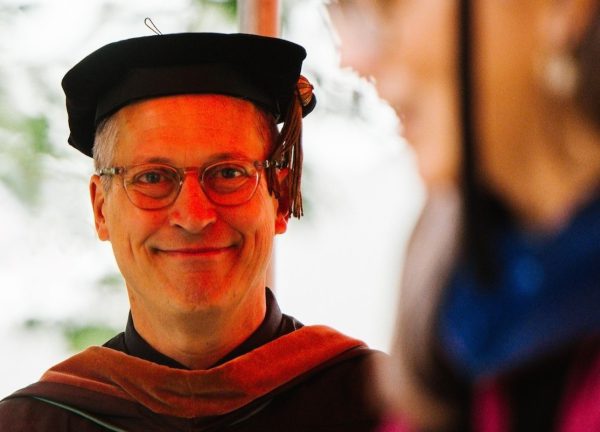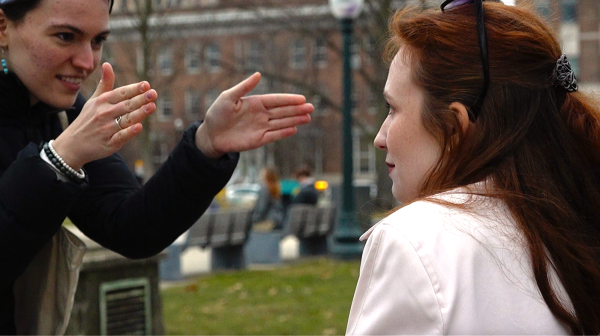Kalamazoo College’s faculty and staff are not only dedicated to developing the strengths of every student—preparing them for lifelong learning, career readiness, intercultural understanding, social responsibility and leadership—they are also recognized for their exceptional scholarship and contributions to their fields. Here are their top news stories of 2024 as determined by your clicks. If you missed it, you can find our top 10 stories of students at our website. Watch in the coming days for our top 10 alumni stories and stories from the College itself.
10. Grant Seeds Petroleum Byproduct Research
Roger F. and Harriet G. Varney Assistant Professor of Chemistry Daniela Arias-Rotondo, affectionately known to her students as Dr. DAR, has earned an American Chemical Society Petroleum Research Fund award. The honor bestows $50,000 to support her students’ research while backing her investigations into petroleum byproducts.

9. Potts Earns Community Medal of Arts Award
The Arts Council of Greater Kalamazoo announced that Professor of Theatre Arts Lanny Potts will be the latest with K connections to receive the Community Medal of Arts Award. Since 1985, the annual award has recognized an artist who is a leader in their field, has a significant body of creative activity, has received local and/or national acclaim, and has impacted the Kalamazoo community through art.

8. Fulbright Chooses K Advisor to Mentor Colleagues
Jessica Fowle ’00—K’s director of grants, fellowships and research—was selected to be a part of the inaugural Fulbright Program Advisor Mentors Cohort. As an FPA mentor, Fowle is one of 20 from around the country who provides virtual training and information sessions, presentations at the Forum for Education Abroad, and personal advice to new Fulbright program advisors who are looking to structure applicant support and recruitment at their own institutions.

7. Moffit Scholarship Fund Honors Professor, Supports Students
As Professor Timothy Moffit ’80 approached retirement this spring, a group of alumni—both classmates and students of Moffit’s—established a scholarship in his honor. The recognition speaks to Moffit’s commitment to the classroom and his students, to business within the framework of the liberal arts, and to his department and the College as a whole.

6. Alumni Honor Complex Systems Studies Professor
Péter Érdi, the longtime Kalamazoo College Luce Professor of Complex Systems Studies, is being honored by five alumni from the Class of 2009 with a fund in his name that will help support a field of study for years to come.

5. Lepley Named Director of Alumni Engagement
Suzanne Lepley, a former dean of admission, was named Kalamazoo College’s director of alumni engagement in May, succeeding Kim Aldrich ’80, who retired after more than 40 years at the College. In her previous role, Lepley recruited thousands of students to K, making personal connections and demonstrating a passion for student success and engagement.

4. Six Faculty Earn Endowed Chair Roles
Endowed chairs are positions funded through the annual earnings from an endowed gift or gifts to the College. The honor reflects the value donors attribute to the excellent teaching and mentorship that occurs at K and how much donors want to see that excellence continue.

Ivett Lopez Malagamba, Alyssa Maldonado-Estrada, Stephen Oloo, Sandino Vargas-Perez and Leihua Weng—from the Spanish, religion, mathematics, computer science and East Asian studies departments respectively—were awarded tenure in 2024 along with promotion to associate professor.

2. K Names Jamie Zorbo ’00 Athletic Director
In addition to serving as head football coach, Zorbo served as K’s interim athletic director during the 2017-18 academic year and as co-interim director in 2023-24. He has served as an assistant athletic director since 2012, overseeing external operations and working closely with the division of advancement to support athletic fundraising efforts.

1. K Thanks Retiring Faculty, Staff
Kalamazoo College bid farewell this spring to several retiring faculty and staff members who dedicated decades of service to the institution as they are retiring. The College thanked them for their significant contributions, the legacies they leave behind, and the indelible marks they have made on students.























